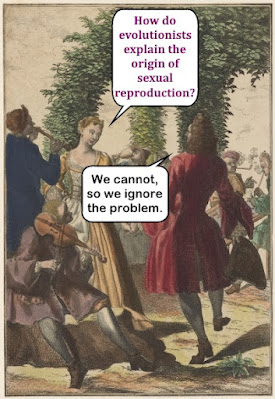Sexual Reproduction Refutes Evolution
When asked how sexual reproduction evolved, especially since an asexual means seems far more efficient, Charles Darwin replied, "I dunno. Hey, kindly give me another cup of that most excellent Ceylon tea, stout fellow!" The Bearded Buddha had no idea, nor do his disciples all these years later.
Sexual reproduction is a problem of irreducible complexity on many levels, since many aspects had to be organized by the Master Engineer and working at the same time. What complicates matter further is that different creatures have different reproduction systems.
 |
| Original image of French social dancing, from the 1800s / NY Public Library |
Darwinists will never realize that God wants us to have pleasure, whether music, colors — or sex. That's for procreation, and also a gift. It could very well be that it is another of our Creator's "Easter eggs" to fluster secularists who deny his existence.
Historically, in Western society, the dominant belief for centuries was the Genesis teaching that the origin of sexual reproduction was a result of creation. After the Darwinian revolution, the origin of sex was explained to be the result of evolution. In short, chance mutations were selected by survival of the fittest, resulting in the evolution of asexual creatures into sexual creatures (Dabhoiwala 2012). Darwinism then “rendered teleology superfluous . . . adaptations are produced by a blind mechanism . . . not the result from conscious design” by God (Ghiselin 1974, 24). Thus, when evolution replaced God as the creator of organic life, an evolutionary explanation was sought for all aspects of life including sexual reproduction (Symons 1979, 60). The origin-of-sex problem is widely recognized by evolutionists today, even after 150 years of investigation since Darwin revolutionized the world with his theory. This “masterpiece of nature” is acknowledged as one of the most difficult evolutionary problems, second only to the origin-of-life problem (Trivers 1983). This is the reason why sexual reproduction is called the “queen of evolutionary problems” (Ridley 2001; Smith 2018, xxix).
Yes, it's that kind of an article: clinical, written by a medical school teacher, with very little go make teenagers giggle. Even so, it's interesting, although a bit long (there is a link to download a PDF if you've a mind to). To continue reading, click on "Evolution of Asexual to Sexual Reproduction."